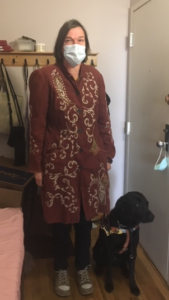How Can You Tell Someone is Smiling When You Can’t See Their Face?
by Beth
A friend just sent an email asking for my advice. Subject line? “How do you recognize a smile when you can’t see the face?”
Starting May 1, 2020, Illinois residents are required to wear masks in any public situation where we are unable to keep a six-foot distance from others. My friend understands the necessity to wear masks, but it’s all bumming her out. “You know me,” she wrote. “When I’m out doing errands, I amuse myself by trying to amuse others.” What now? How will she know her jokes are funny if she can’t see people smiling?
Under normal circumstances (remember those?!) I can hear a smile in someone’s voice. That skill didn’t come automatically when I lost my sight. They didn’t teach us that at the rehabilitation center I was sent to after losing my sight, either. I had to figure it out on my own, and that took time.
I wasn’t blind long before discovering how much I’d relied on lip reading to communicate back when I could see. Lip-reading, and body language, too. You see a person look at you, maybe give you a nod, and start moving their lips? Odds are they are talking to you. Now, sometimes, I don’t have a clue.
Anyone seated on a stool next to me at a local diner would inevitably witness my difficulties in addressing the server. I hear one come near, they ask, “More coffee?” and I assume they are talking to me. If they’re not, and I respond? Awkward.
Ditto those times when a pharmacist, a bank teller, a post office clerk, a TSA employee, a ticket counter worker (actually, any circumstance where I have to stand in line) calls out, “you’re next.” After inadvertently cutting in line hundreds of times, I finally figured out to point at myself and ask, “Me?” before making a move.
And then there’s the time my husband Mike and I sat down at a bar we didn’t frequent much and I asked a bartender what they had on draft. Little did I know I was sitting smack dab in front of all the beer pulls. The bartender pointed at the pulls (I think) and said, “What are you, blind?”
Good guess.
But back to smiles. When I first started recording essays for NPR, radio pros there encouraged me to smile while talking on the radio. “A smile comes through even when you can’t see the person who is smiling,” they said. “Even if you are saying something that isn’t exactly funny, you should smile: it engages listeners.” After that I started hearing smiles on the radio. (For a good example of a radio announcer who smiles when reading announcements, ask your smartspeaker to “play WBEZ” in the afternoon and listen to our Chicago Public Radio All Things Considered host Melba Lara — she’s always smiling, and always engaging).
It wasn’t long before I could detect smiles in everyday life, too. When I’m not quite sure? I can always turn to Mike. “Does Emily have a pretty smile?” I might ask. “She always sounds like she’s smiling.”
With many states requiring masks in public now, voices are muffled, lip-reading is impossible, judging whether people are addressing us is more difficult. So how can my friend know someone is smiling without being able to see their face? With no evidence to the contrary, just picture they are.







May 8th, 2020 at 9:09 am
.Thank you Easter Seals for highlighting this woman. Beth Finke has overcome a disability only to enhance the lives of all those she reaches. I’m smiling !